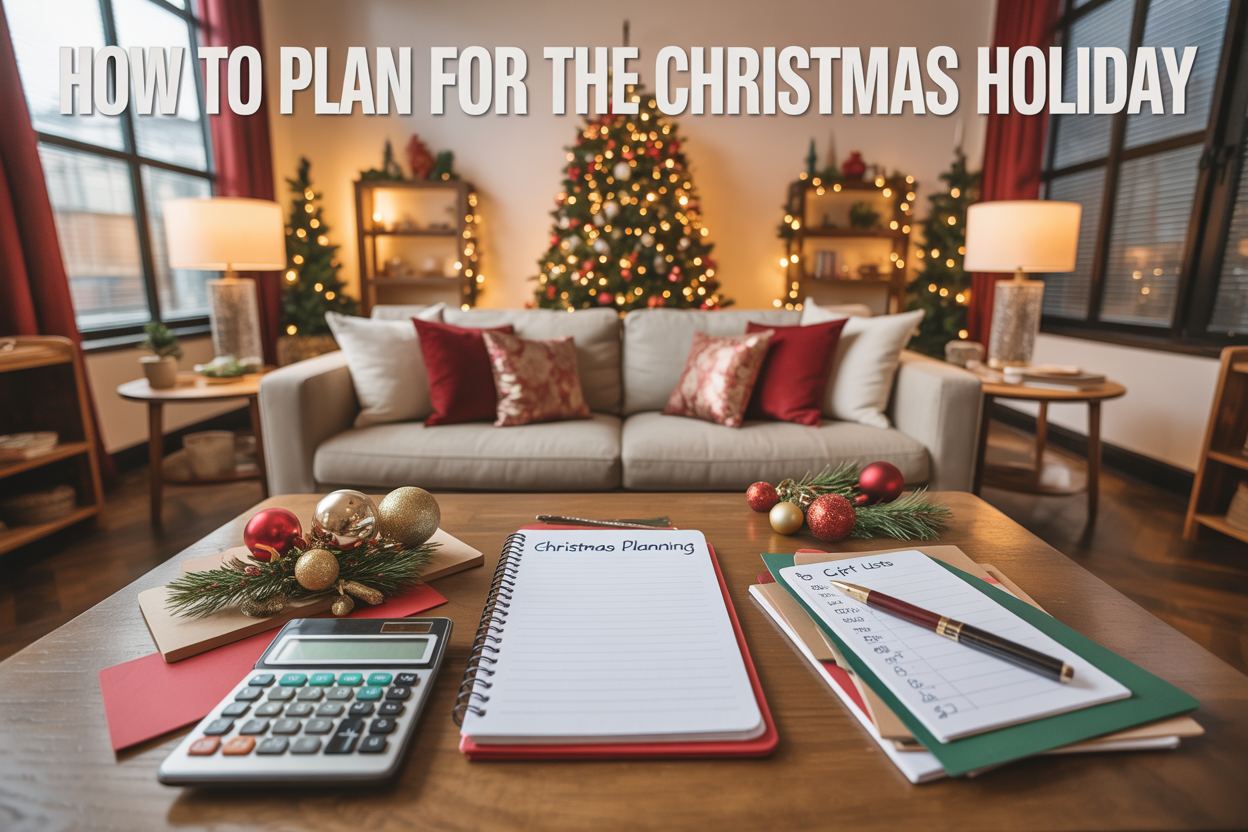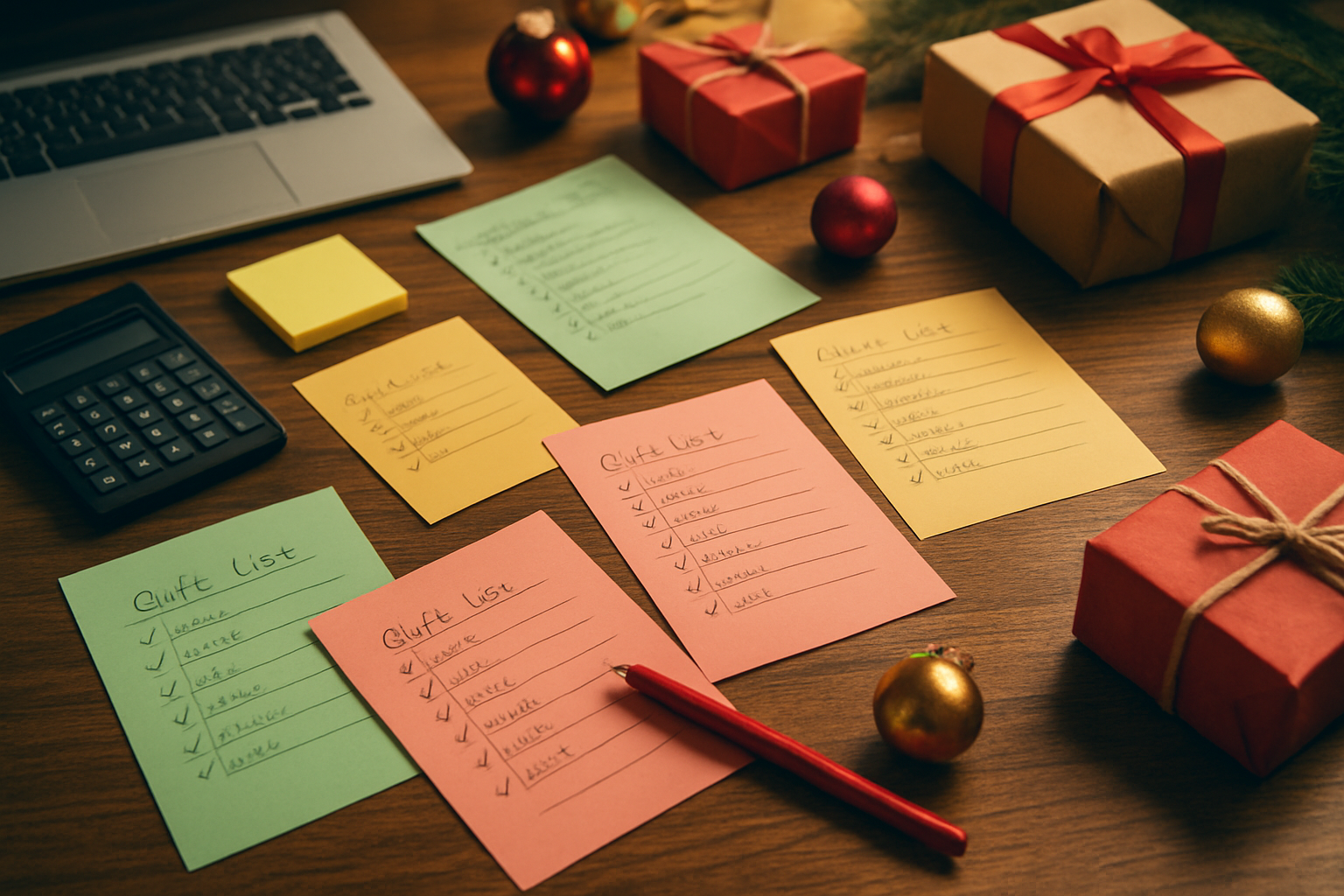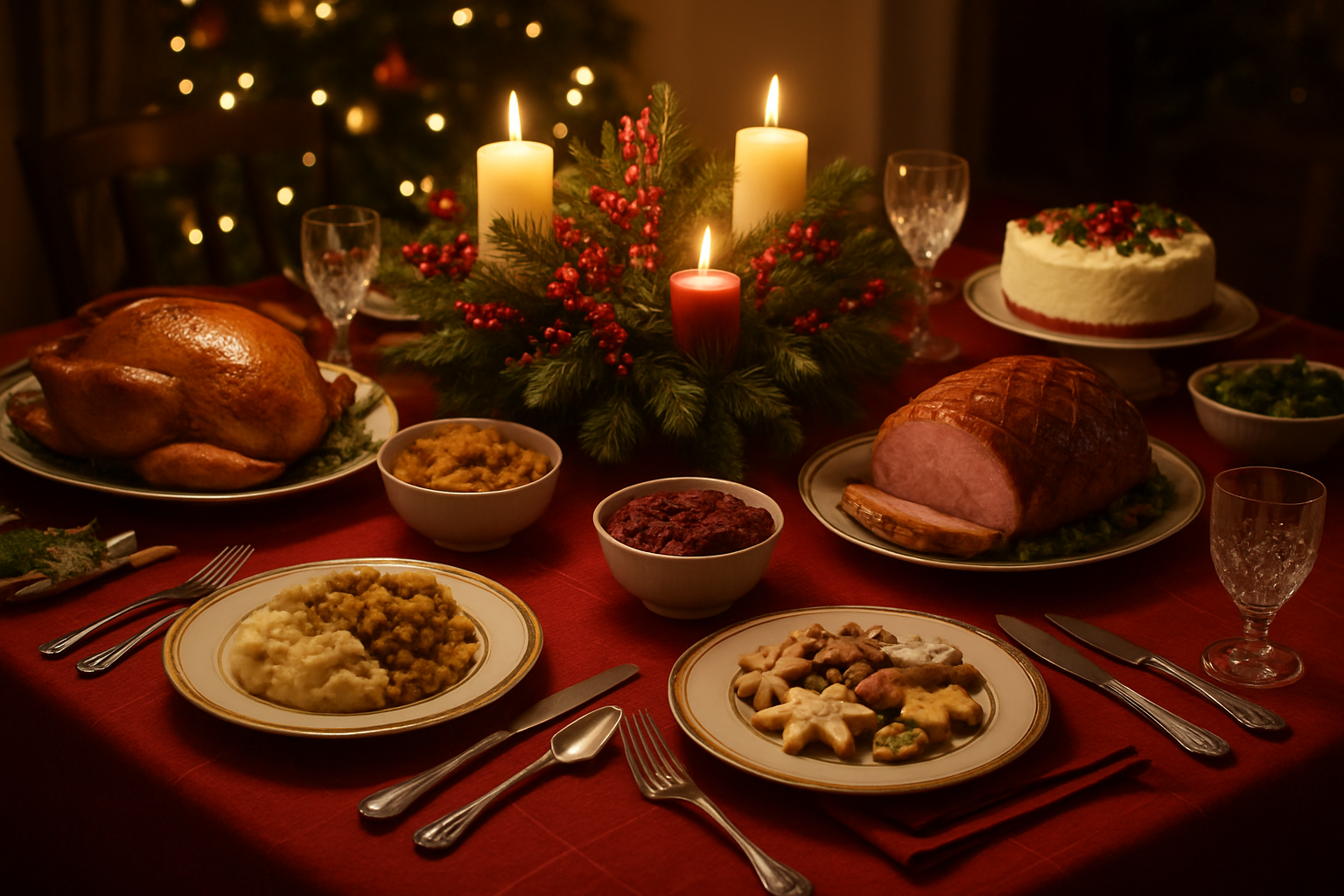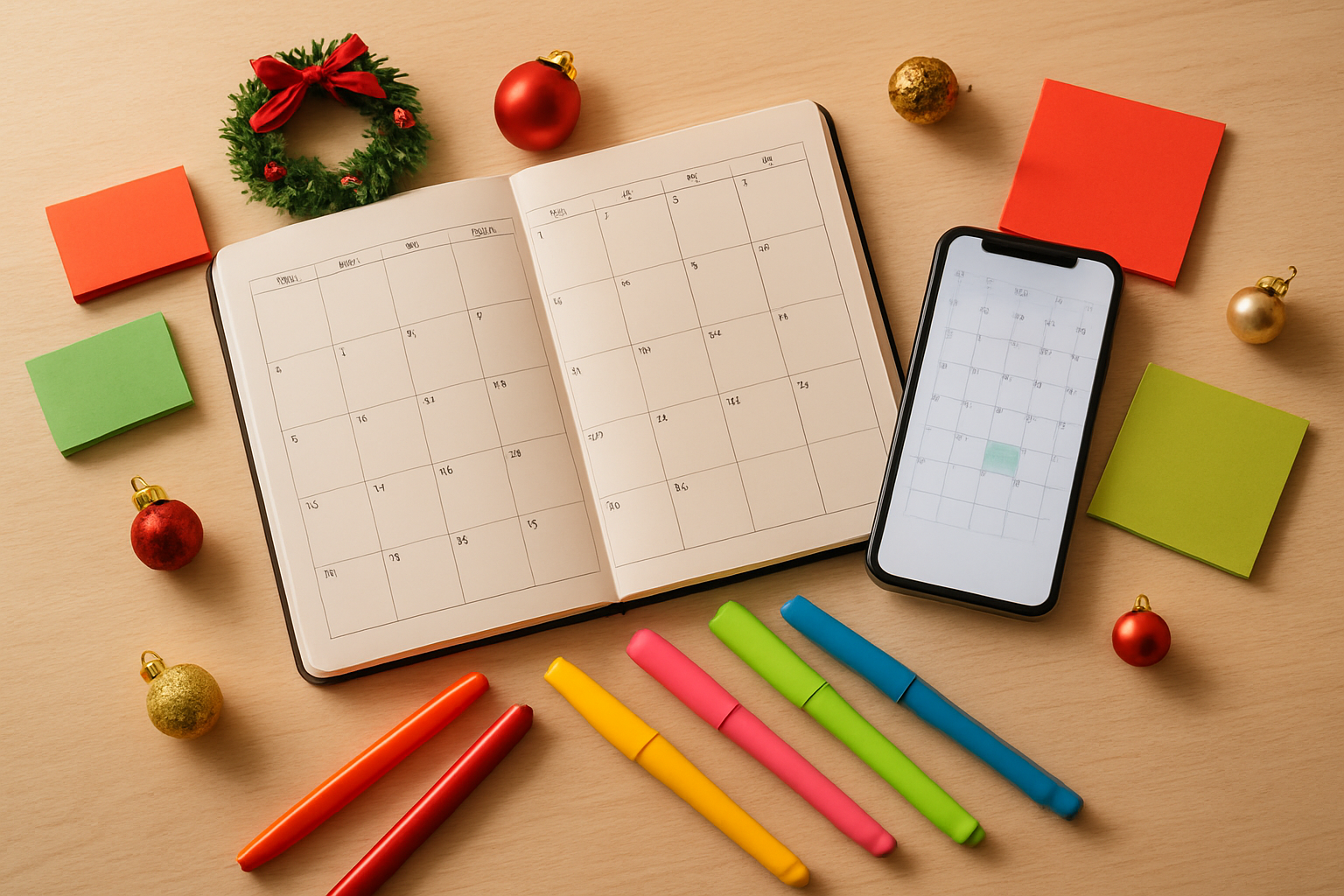HOW TO PLAN FOR THE CHRISTMAS HOLIDAY

Planning for the Christmas holiday doesn't have to feel overwhelming when you start early and stay organized. This comprehensive guide helps busy families, first-time hosts, and anyone wanting a stress-free December create their perfect holiday experience.
We'll walk you through setting a realistic Christmas budget that prevents January financial stress and show you how to create smart gift lists that make shopping efficient. You'll also discover simple strategies for holiday menu planning and entertaining that impress guests without exhausting yourself, plus practical tips for organizing your schedule and decorating your home.
With the right Christmas preparation checklist, you can enjoy the magic of the season instead of scrambling through last-minute chaos.
Set Your Christmas Budget Early

Calculate Total Available Spending Money
Before diving into Christmas shopping, take a realistic look at your finances. Start by reviewing your monthly income and existing expenses to determine how much you can comfortably allocate for Christmas holiday planning without straining your budget. Consider all income sources, including salary, bonuses, side hustles, or any expected holiday bonuses from work.
Subtract your fixed monthly expenses like rent, utilities, groceries, and debt payments from your total income. The remaining amount gives you a baseline for discretionary spending. From this figure, decide what percentage feels comfortable for holiday expenses - most financial experts recommend keeping holiday spending to 1-2% of your annual income.
Allocate Funds for Gifts, Food, and Decorations
Smart Christmas budget planning requires breaking down your total holiday fund into specific categories. A proven approach is the 50-30-20 rule for holiday spending: allocate 50% for gifts, 30% for food and entertaining, and 20% for decorations and miscellaneous expenses.
Gift Budget Breakdown:
-
Immediate family: 40-50% of gift budget
-
Extended family: 25-30% of gift budget
-
Friends and coworkers: 15-20% of gift budget
-
Teachers, service providers: 5-10% of gift budget
Food and Entertainment Allocation:
-
Holiday meals and parties: 60-70%
-
Special treats and baking supplies: 20-30%
-
Beverages and cocktail ingredients: 10-20%
Decoration and Miscellaneous:
-
New ornaments or decorations: 40-50%
-
Wrapping paper and cards: 20-30%
-
Holiday activities and outings: 20-30%
Create Separate Savings Account for Holiday Expenses
Opening a dedicated holiday savings account prevents Christmas spending from mixing with your regular finances. Many banks offer special holiday savings accounts that automatically transfer small amounts from your checking account throughout the year.
Set up automatic transfers starting in January - even $25-50 per month adds up to $300-600 by December. Some banks offer Christmas clubs that restrict withdrawals until November, helping you avoid the temptation to dip into holiday funds early.
Consider using a high-yield savings account to earn interest on your holiday fund throughout the year. Online banks typically offer better rates than traditional banks, helping your Christmas money grow while you wait.
Track Spending with Budgeting Apps or Spreadsheets
Monitoring your holiday expenses prevents overspending and keeps you accountable to your Christmas budget planning goals. Choose a tracking method that matches your tech comfort level and spending habits.
Popular budgeting apps for Christmas planning:
-
Mint: Categorizes expenses automatically
-
YNAB (You Need A Budget): Helps allocate every dollar
-
PocketGuard: Shows available spending money
-
Holiday Money: Specifically designed for seasonal budgeting
Simple spreadsheet tracking includes:
-
Date of purchase
-
Item or recipient
-
Amount spent
-
Category (gifts, food, decorations)
-
Remaining budget in each category
Update your tracking system after every holiday purchase, not just weekly or monthly. This real-time awareness helps you make better spending decisions and catch budget overruns before they become major problems.
Create Comprehensive Gift Lists

List All Recipients and Their Interests
Start your Christmas gift list ideas by creating a master list of everyone you want to give gifts to this year. Break down your recipients into categories like immediate family, extended family, friends, coworkers, teachers, and neighbors. This systematic approach prevents you from forgetting anyone important while keeping your Christmas holiday planning organized.
For each person on your list, jot down their current interests, hobbies, and needs. Think about what they've mentioned wanting lately, what they've been passionate about, or what problems they're trying to solve. Your teenage nephew might be obsessed with gaming, while your sister could be diving deep into her new yoga practice. These insights become the foundation for meaningful gift selection.
Keep notes throughout the year when people mention things they want or need. Many people drop hints months before Christmas, and writing these down creates a treasure trove of gift ideas when December rolls around. Consider creating a simple spreadsheet or using your phone's notes app to track these observations.
Don't forget about life changes that might influence gift preferences. Someone who recently moved might appreciate home essentials, while a new parent could use practical baby items or self-care products. Recent graduates, job changers, or retirees all have evolving needs that make for thoughtful gift opportunities.
Set Spending Limits for Each Person
Christmas budget planning requires setting realistic spending limits for each recipient before you start shopping. Assign dollar amounts based on your relationship with each person and your overall holiday budget. Close family members might warrant higher spending limits, while coworkers or acquaintances typically receive smaller gifts.
Create spending tiers that make sense for your situation. You might have $100-150 for immediate family, $50-75 for extended family, $25-50 for friends, and $10-25 for coworkers or teachers. Writing these amounts next to each name helps you stay disciplined during shopping trips and prevents impulse purchases that can derail your budget.
Consider the reciprocal nature of gift-giving relationships. If you typically exchange gifts of similar value with someone, aim to match that expectation. However, don't feel pressured to overspend if your financial situation has changed. Most people appreciate thoughtful gifts regardless of their price tag.
Remember that some of the most meaningful gifts don't require large budgets. Homemade items, personalized photo albums, or experiences you can share together often hold more sentimental value than expensive purchases. Factor in time and effort when calculating the true value of your gifts.
Research Gift Ideas and Compare Prices
Once you have your recipients and budgets established, begin researching specific gift options. Start by browsing online retailers, reading product reviews, and checking social media for trending items in your recipients' interest areas. Create a shortlist of potential gifts for each person, including backup options in case your first choice becomes unavailable or exceeds your budget.
Price comparison becomes crucial for maximizing your Christmas budget. Use price-tracking websites and browser extensions to monitor costs across different retailers. Many items go on sale throughout the holiday season, and knowing the regular price helps you recognize genuine deals versus marketing gimmicks.
Consider the total cost of each gift, including shipping, taxes, and any customization fees. Sometimes a slightly more expensive item from a local store becomes cheaper than an online purchase once you factor in shipping costs and delivery times. For personalized items, account for extra production time in your planning schedule.
Keep a running list of potential sales events and promotional periods. Black Friday, Cyber Monday, and end-of-year clearances offer significant savings opportunities, but many retailers run smaller promotions throughout November and December. Sign up for newsletters from your favorite stores to receive advance notice of sales and exclusive discount codes.
Track your research in a simple format that includes the recipient's name, gift ideas, prices from different stores, and any special notes about availability or shipping requirements. This organized approach streamlines your actual shopping experience and helps you make quick decisions when time becomes limited.
Plan Your Holiday Menu

Decide on Traditional Versus New Recipes
Choosing between beloved family traditions and exciting new dishes can make or break your holiday menu planning. Start by identifying your absolute must-haves - those recipes that wouldn't feel like Christmas without them. Maybe it's your grandmother's stuffing recipe or that special cranberry sauce that everyone expects. Write these down as your non-negotiables.
Once you've secured your traditional favorites, consider adding one or two new dishes to keep things fresh. Pick recipes you can test beforehand, ideally a month before Christmas. This gives you time to adjust seasonings and cooking methods without the holiday pressure. New appetizers work particularly well since they don't compete with main course expectations.
Consider your cooking skills honestly when evaluating new recipes. Complex dishes with unfamiliar techniques aren't the best choice for busy Christmas preparation. Look for recipes that use familiar cooking methods but offer new flavor combinations or presentations.
Calculate Food Quantities for Expected Guests
Getting portions right prevents both food waste and the nightmare of running short during dinner. Create a detailed guest list first, noting any dietary restrictions, big eaters, and light eaters in your group.
Here's a practical breakdown for Christmas dinner planning:
| Food Category | Amount Per Person | Notes |
|---|---|---|
| Turkey/Ham | 1-1.5 lbs (with bone) | Include leftovers in calculation |
| Side Dishes | 1/2 cup each | Plan 3-4 different sides |
| Appetizers | 4-6 pieces | Reduce if serving cocktail hour |
| Dessert | 1 serving + 25% extra | Account for multiple dessert lovers |
Remember that people eat more during celebrations, and Christmas leftovers are part of the tradition. Add 10-15% to your base calculations to ensure plenty of food. For beverages, plan two drinks per person for the first hour, then one per hour after that.
Prepare Make-Ahead Dishes and Shopping Lists
Smart Christmas entertaining means doing as much prep work as possible before your guests arrive. Identify dishes that actually taste better after sitting overnight - like casseroles, soups, and many desserts. These become your make-ahead priorities.
Create separate shopping lists for different time periods:
-
Two weeks before: Non-perishable items, frozen goods, and pantry staples
-
One week before: Fresh produce that keeps well, dairy products
-
2-3 days before: Fresh herbs, delicate vegetables, and last-minute items
Many traditional holiday dishes freeze beautifully. Prepare and freeze items like dinner rolls, pie crusts, and even some fully assembled casseroles up to a month ahead. Label everything clearly with contents and reheating instructions.
Prep vegetables 1-2 days early by washing, chopping, and storing them properly. This simple step saves hours on cooking day and reduces kitchen stress significantly.
Coordinate Potluck Contributions with Family and Friends
Potluck coordination prevents duplicate dishes and ensures balanced meal variety. Start planning potluck assignments at least three weeks before Christmas. This gives everyone time to plan and shop without last-minute scrambling.
Create categories that make sense for your gathering:
-
Appetizers and drinks: Easy for guests who aren't confident cooks
-
Side dishes: Perfect for those wanting to contribute something substantial
-
Desserts: Great option for people with specialty baking skills
-
Bread and rolls: Simple but essential contribution
Send a group text or email with available categories and let people choose their preferences. Keep a running list to track what's covered and what's still needed. Don't forget to coordinate serving dishes, utensils, and warming instructions.
Ask contributors to bring their dishes in disposable containers when possible, or clearly label their own dishes for easy identification later. This prevents the annual mystery of whose beautiful serving bowl belongs to whom.
Organize Your Holiday Schedule

Mark Important Dates on Calendar Early
Getting organized starts with marking all your Christmas-related dates on your calendar as soon as possible. Don't wait until December to figure out when Christmas parties, family gatherings, school concerts, and work events are happening. Start filling in your calendar in October or early November.
Create a master list of all the events you know about: office holiday parties, neighborhood gatherings, kids' school performances, church services, family traditions, and any special celebrations. Add travel dates if you're visiting relatives or hosting guests. Include shopping deadlines, like the last day for online orders to arrive on time, and mark when you want to have all your gifts wrapped.
Use different colors for different types of events - red for family gatherings, green for social events, blue for work obligations. This visual system helps you spot potential conflicts and busy periods at a glance. Digital calendars work great because you can set reminders and share them with family members.
Balance Family Obligations with Personal Downtime
Holiday schedule organization means finding the sweet spot between honoring family traditions and keeping your sanity intact. Christmas can quickly become a marathon of events that leaves you exhausted instead of joyful.
Look at your calendar and identify the must-attend events versus the nice-to-attend ones. Be honest about what matters most to your family and which gatherings truly bring you joy. It's okay to say no to some invitations, especially if your schedule is packed.
Build buffer time around major events. If you're hosting Christmas dinner, don't schedule anything the day before or after. You'll need prep time and recovery time. Block out quiet evenings at home for gift wrapping, decorating, or simply relaxing with hot cocoa and holiday movies.
Consider alternating years for certain obligations. Maybe you visit Aunt Sarah's annual cookie exchange every other year instead of feeling guilty about missing it. Create boundaries that protect your energy while still maintaining important relationships.
Book Travel Arrangements and Accommodations
Travel planning during the holidays requires early action and flexibility. Christmas travel prices skyrocket and availability disappears fast, so start booking flights, hotels, and rental cars by early October if possible.
Compare prices across different travel dates. Flying on Christmas Eve or Christmas Day is often cheaper than the weekend before. If you're driving, map out your route and identify hotels along the way in case weather delays your trip. Book accommodations with flexible cancellation policies when possible.
Consider alternative airports and travel methods. Sometimes flying into a nearby city and driving the rest of the way saves money and stress. Train travel can be more relaxing than flying during busy holiday periods.
If you're hosting visitors, prepare guest rooms early and communicate arrival details clearly. Share your holiday schedule with guests so they know what to expect and can pack appropriately.
Plan Time Off From Work Strategically
Smart holiday planning means looking at the calendar and requesting vacation days strategically. Many people want the same days off, so submit your requests early - ideally by September or October.
Look for opportunities to maximize your time off with minimal vacation days. If Christmas falls on a Tuesday, taking Monday off gives you a four-day weekend. Consider the days between Christmas and New Year's, when many offices are quiet anyway.
Coordinate with your team to ensure coverage while you're away. Create detailed handoff notes and set up out-of-office messages that direct urgent matters to specific colleagues. Finish major projects before your break so you can truly disconnect.
Plan a buffer day before returning to work. Coming back from vacation on a Monday morning can feel jarring. Taking an extra day to settle back into your routine, catch up on personal tasks, and mentally prepare makes the transition smoother.
Schedule Gift Wrapping and Decoration Time
Don't leave gift wrapping and decorating for the last minute. These tasks take longer than you think and can become stressful when rushed. Schedule specific time blocks for these activities throughout December.
Set aside several evenings for gift wrapping. Create a wrapping station with all your supplies - paper, ribbons, scissors, tape, gift tags - in one convenient location. Put on holiday music or movies to make it enjoyable rather than a chore.
Plan decoration time in phases. Start with outdoor lights and decorations when the weather is still mild. Move indoors with garlands and general decorations, saving the Christmas tree for last. This staged approach prevents decoration fatigue and lets you enjoy the process.
Consider hosting a wrapping party with friends or family members. Everyone brings their gifts and supplies, and you help each other while enjoying snacks and holiday music. It transforms a solitary task into a fun social event and gets everyone's presents ready efficiently.
Prepare Your Home for the Holidays

Declutter Spaces Before Decorating
Getting your home ready for Christmas decorating starts with clearing the decks. You can't create that magical holiday atmosphere when you're fighting through piles of clutter and cramped spaces. Start by tackling one room at a time, removing unnecessary items from surfaces, shelves, and floors where decorations will go.
Focus on high-traffic areas first - your living room, dining room, and entryway are prime real estate for Christmas displays. Pack away everyday decorative items temporarily, storing them in labeled boxes so you can easily find them after the holidays. Don't forget about tabletops, mantels, and windowsills - these spots need breathing room for garlands, candles, and festive centerpieces.
Create designated storage areas for items you're temporarily removing. This prevents your decluttering effort from just moving mess from one spot to another. Your Christmas home decorating will look more polished and intentional when each decoration has proper space to shine without competing with everyday objects.
Plan Decoration Themes and Color Schemes
Smart Christmas preparation starts with choosing a cohesive look before you start hanging ornaments randomly. Pick a main color palette - whether that's classic red and green, elegant gold and silver, or trendy navy and copper - and stick with it throughout your home. This creates flow and prevents your decorations from looking scattered or chaotic.
Consider your existing home decor when planning your holiday theme. If your living room features warm earth tones, incorporating burgundy and gold Christmas accents will blend beautifully. For modern homes with neutral colors, a minimalist approach with white lights and simple silver ornaments might work better than traditional busy patterns.
Create a simple decoration map noting which rooms get which elements. Maybe your kitchen gets a smaller tabletop tree while your living room showcases the main Christmas tree. Planning prevents over-decorating some areas while leaving others bare, and helps you shop more efficiently for specific items rather than buying random decorations that might not work together.
Test and Replace Holiday Lights Before Hanging
Nothing kills the Christmas decorating momentum like discovering half your light strings are dead after you've already spent an hour untangling them. Test every strand before you even think about hanging them up. Plug each set in and check for burnt-out bulbs, frayed wires, or sections that don't light up.
Replace any faulty bulbs immediately - most hardware stores carry replacement bulbs for standard light sets. For LED lights with individual bulb issues, sometimes the problem is a loose bulb rather than a dead one. Give each bulb a gentle twist to ensure it's properly seated in its socket.
Keep a simple inventory of what works and what needs replacing. Write down how many strands you need for each area: the tree, outdoor bushes, indoor garlands, and any other spots in your holiday planning guide. This prevents last-minute shopping trips when stores are picked over and prices are higher.
Buy a few extra strands beyond what you think you need. Having backups means you won't be stuck with a half-lit display if something fails mid-season. Store your tested, working lights carefully after the holidays - proper storage prevents the tangled mess that makes next year's setup so frustrating.

Getting your Christmas plans sorted early makes all the difference between a stressful scramble and a truly enjoyable holiday season. When you set your budget first, make those gift lists, plan your menu, organize your schedule, and prep your home ahead of time, you're setting yourself up for success. These simple steps help you avoid last-minute panic shopping, overspending, and the chaos that can steal the joy from what should be your favorite time of year.
Start tackling your Christmas planning now, even if it feels early. Your future self will thank you when December rolls around and you're actually able to relax and enjoy time with family and friends instead of running around like crazy. The holidays are meant to be about connection and celebration, not stress and exhaustion. A little planning goes a long way toward making sure your Christmas is everything you want it to be.
Comments
Post a Comment